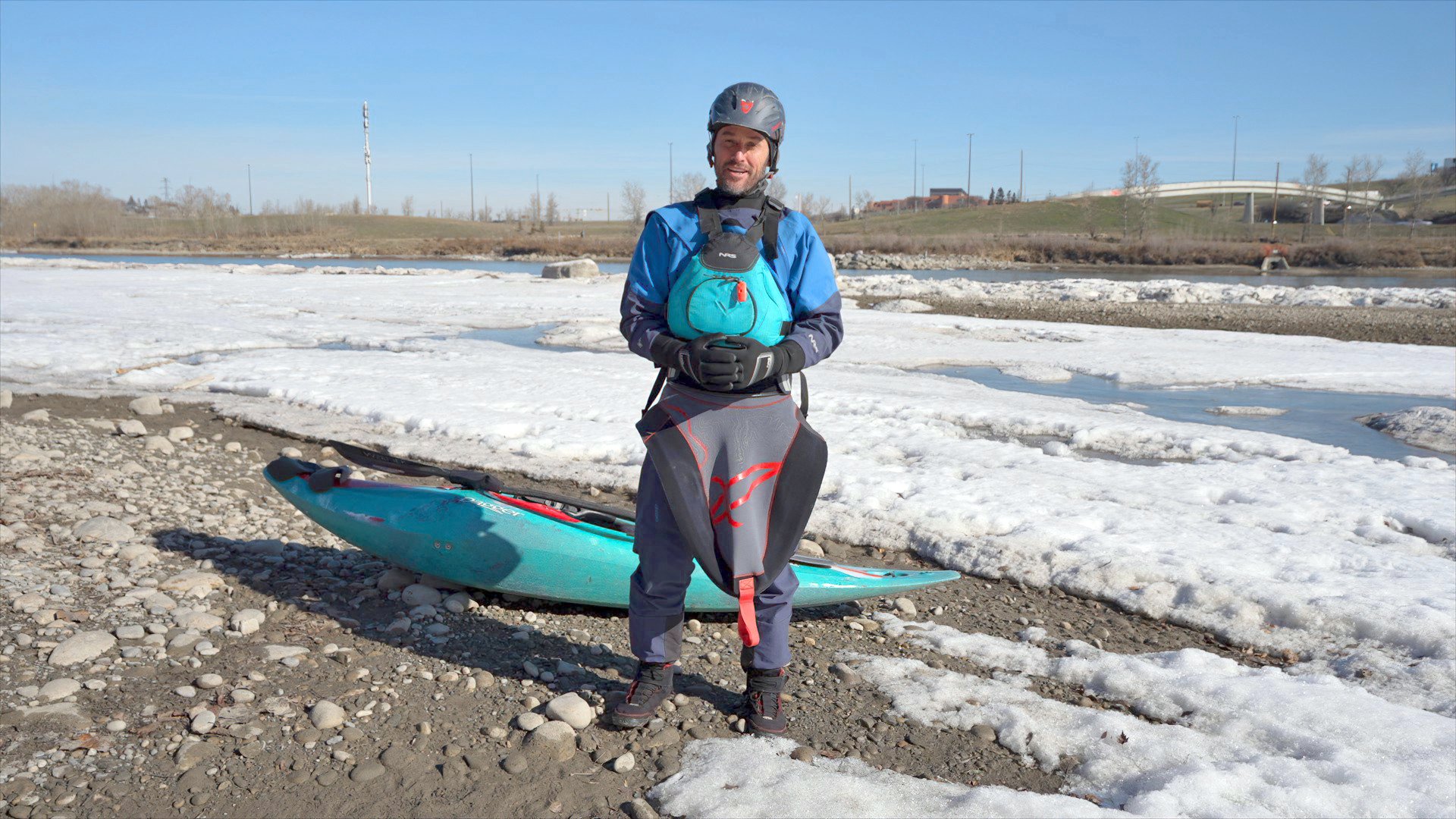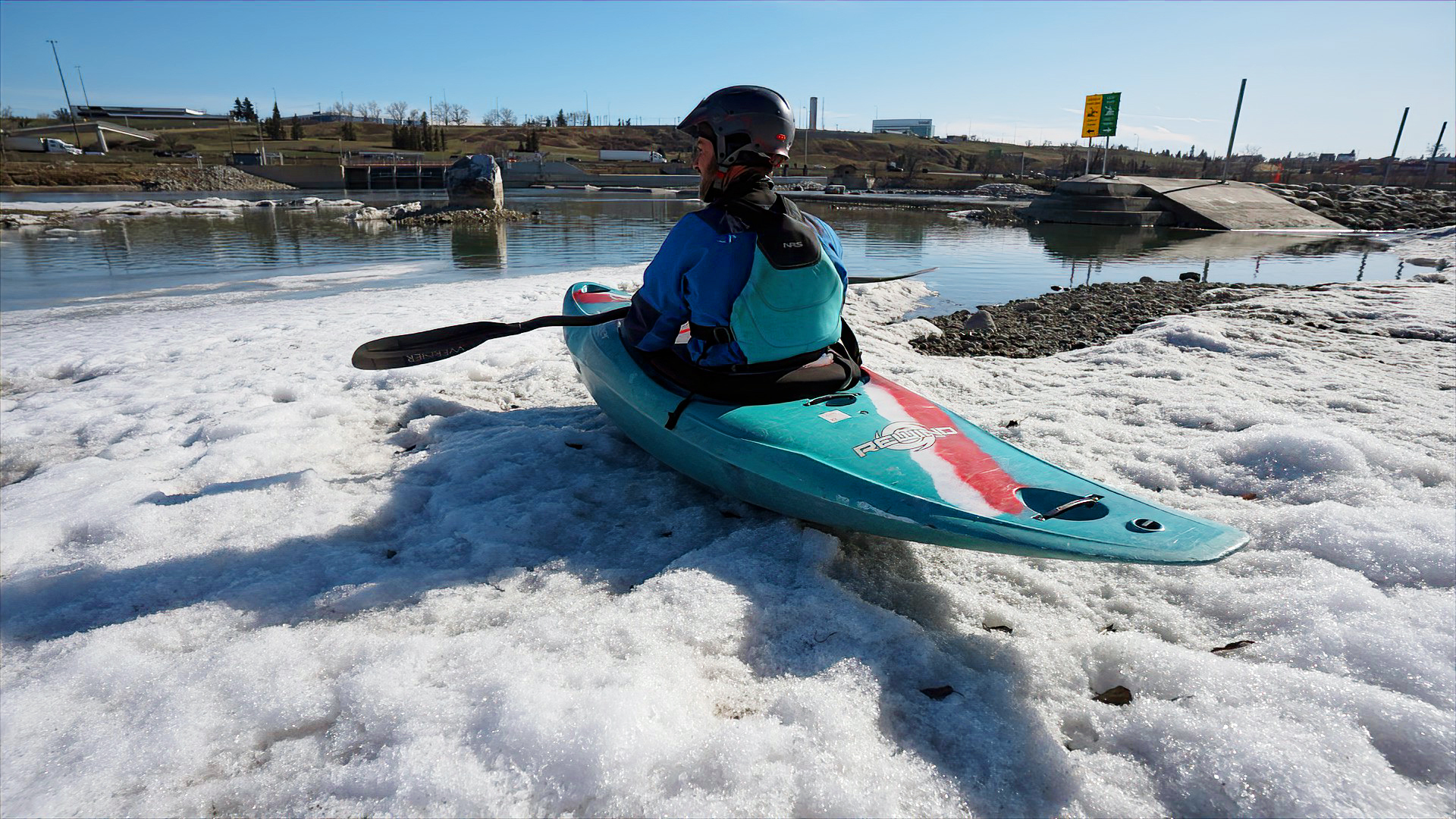There is no reason for the boating season to end, as long as you know how to dress for success. Winter offers some of the most rewarding whitewater experiences, with few others out on the river and stunning scenery. The key to enjoying winter paddling is dressing for comfort and safety. Simon Coward, owner of AQ Outdoors (AQ Outdoors is a paddling shop and school with locations in Calgary and Edmonton), is here to share his thoughts on the gear you need for cold-weather paddling. The following is a transcript of his video review.

Beat The Cold With These Winter Paddling Must-Haves
Simon here from AQ Outdoors. I’m checking in from Harvey Passage here on a cool April morning with some tips and tricks around getting ready for spring paddling and paddling in colder temperatures.
Our season really never ends. Some people paddle year-round on the Kananaskis River, and they’re paddling down to -8 or -10 degrees (celsius). It’s not quite that cold right now. The philosophies though are the same.
We’re trying to dress for comfort and for safety. So if we do happen to wind up in the water and take a bit of a swim, we’re not going to end up in dire circumstances as far as cold water immersion goes, because that can sneak up on us very quickly.
Layering
For me personally, when I’m dressing for colder temperatures and longer days on the water, I’m thinking about layering.
I’m basically going to wear a fleece onesie. I wear a relatively thick one. I’ll wear a base layer on my upper body.
I’ll wear ski socks on my feet and then I wear my dry suit over the top. Then over my dry suit I wear socks. A, for some thermal protection. But B, to protect the dry socks in the dry suit. I’ll wear thin neoprene socks over the top and then some pretty beefy sort of creeking river shoes over the top of that as well.
Now if I end up standing in the water for a rescue or for any period of time I’m giving my toes the best chance of not freezing off.
Safety Gear
Then we have safety gear. Obviously, we carry all of our safety gear.
We’ve got a neoprene spray skirt which adds an additional layer of insulation here because we have that tunnel that goes up with our PFD which is also some insulation.
Then I wear a neoprene hood. I just wear a half-cut one that just goes over my ears. I have a nice thick helmet with lots of foam in it. This has a lot of insulation just by nature.

Gloves And Pogies
Now for gloves. For the longest time, I didn’t wear gloves or anything on my hands. I just sucked it up and kind of did the old every five minutes or so. But now I’ve decided that wearing gloves is A-Okay with me.
Now this depends on the temperature of the water and the temperature of the day. I’ve got NRS Maxim gloves on here which are quite thick, waterproof gloves, so really cold water gloves. They do take a lot of feel off the paddle though so a lot of people don’t like them.
Another option I’ve been growing increasingly fond of are pogies. Basically, pogies allow you to put your hands inside the neoprene sleeve and still have feel on the paddle, so you don’t feel like you’ve got this big barrier between you and the paddle shaft. They don’t offer necessarily as much thermal protection as gloves or mitts, but they certainly do take the edge off with wind, and they do keep a lot of the splashes off.

Comfort Equals Safety And Progression
In a nutshell when we’re dressing for cold water paddling, like I mentioned, at the start we want to be comfortable. We want to have the freedom to move. We don’t want to feel all claustrophobic and that we can’t rotate or anything because that really affects performance and in turn enjoyment.
But we also do need to be fairly aware of what the implications are if we do end up in the water.
Part of that can just be planning early season, when it’s cold and you’re a bit rusty, maybe paddle stuff that you’re really comfortable with and the likelihood of a swim is much lower.
[ Get the skills for winter whitewater with a class at AQ Outdoors ]
As that water warms up, and your strength and confidence build, progress through the grades, and by the mid-summer or late summer, you’re going to be cranking. Then you can start pushing into some harder whitewater.
AQ Outdoors offers retail and kayak instruction in Calgary and Edmonton. Learn more about their school and stores at AQOutdoors.com.







25017_05_Black_na_Pair_031422_1000x1000-product_rotator_gear.jpg)

